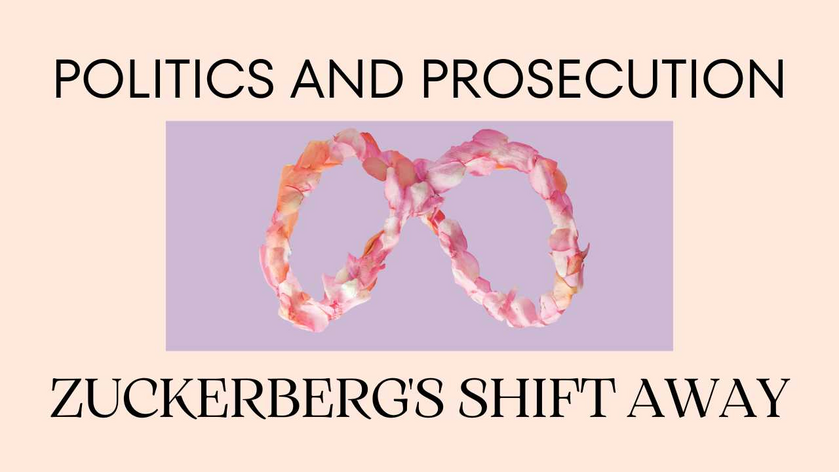An astonishing development took place yesterday in the checkered history of Meta, Inc., owners of Facebook, Instagram, and WhatsApp. Four weeks ago, Mark Zuckerberg, CEO of Meta, abruptly confessed to the censorship his platforms practiced for years. Now The New York Times reports that he has hired a Republican “strategist” and plans to disengage from politics completely. Reactions to his apparent “rebranding” very from skepticism to open scorn. But that he would even attempt such “rebranding” shows that the “nationalist populism” of Donald J. Trump is more powerful than anyone has yet realized.
Recent moves by Zuckerberg
Nearly a month ago, Zuckerberg confessed his sins of censorship, false witness, and interference with business relationships. He set forth details in a letter to Rep. Jim Jordan (R-Ohio), Chairman of the House Committee on the Judiciary and its Subcommittee on the Weaponization of the Federal Government.
https://x.com/JudiciaryGOP/status/1828201780544504064
Specifically he confessed to censorship of the Hunter Biden Laptop story and two aspects of the coronavirus “pandemic”:
Exaggeration of the harms from coronavirus infection, especially to those not suffering from chronic illnesses, and
Denial or minimization of the harm from coronavirus vaccines.
Zuckerberg did not discuss his censorship of theories on the origin of coronavirus. Anyone challenging the official Wet Market Theory could expect content takedowns, shadow bans, “Facebook jail,” or ejection from Meta platforms. But he did discuss his “Zuckerbucks” program of financial support for local voter registration and elections offices. While not admitting any bias in such contributions or other wrongdoing, he announced suspension of the program.
In that letter he specifically accused the Biden administration of coercing him to do the censorship. But he did not and could not accuse the government of compelling him to make those “Zuckerbucks” contributions. Under no legal theory could he have claimed that excuse. That would constitute a taking of private property for public use without compensation, in violation of Amendment V. Which reads in relevant part:
[P]rivate property shall [not] be taken for public use, without just compensation.
Reaction
Two weeks later, Rebecca Friedrichs, a conservative education activist, had two words to say to Zuckerberg: “Prove it!” In her essay on RealClearPolitics, she described her own shadowbanning, on Facebook and Twitter (now known as X). She also charged that she lost her personal Facebook page the day after Rep. Jordan released Zuckerberg’s letter. More to the point, Ms. Friedrichs described the damage by Meta’s Trust and Safety Teams, and those of other platforms:
Deaths of patients suffering chronic illnesses, deaths which coronavirus infection precipitated, because hydroxychloroquine and ivermectin were unavailable or forbidden.
Deaths and complications from “vaccines” issued under Emergency Use Authorizations, “vaccines” now shown to provide no benefit.
Election interference, in that many blithely voted for Biden, believing that the Hunter Biden Laptop was a Russian disinformation trick.
Children losing two years of learning because schools closed when they could have opened.
Sexualization of children – and either their grooming into “transitioning,” or violent acts that “transitioned” students perpetrated on fellow students.
Skeptics on X directed their fire in equal measure at Zuckerberg and Rep. Jordan. All wanted to know what, if anything, Jordan or Rep. Mike Johnson (R-La.), Speaker of the Housse, would do next.
Meanwhile, the case of Missouri v. Biden is back before Judge Terry A. Doughty of the U.S. District Court for the Western District of Louisiana. Facebook’s activities have figured prominently in that case – and now the government has filed another motion to dismiss.
The New York Times piece
Theodore Schleifer and Mike Isaac of The New York Times published their piece two nights ago, and updated it yesterday. Anyone writing for an organ like The New York Times, necessarily writes from a leftist perspective. Their article does not suggest that Mark Zuckerberg has turned conservative. Rather, they suggest he no longerr wants to play the high-stakes political games he once played. Republicans despise him for his injuries to them, and Democrats, having used him, have hung him out to dry. So now he wants, Pilate-like, to wash his hands of these affairs.
Citing anonymous sources within Meta, Schleifer and Isaac say Zuckerberg really has suspended all partisan programs. Likewise he has started moving against overt political activism at Meta. But those sources likely represent troublemakers at Trust and Safety who either didn’t get The Memo, or tore it up when they did get it. That would explain Rebecca Friedrichs’ continued shadowbanning and other difficulties.
Schleifer and Isaac suggest that Zuckerberg and his wife, Dr. Priscilla Chan, have had some shocking experiences lately. Those shocks might have soured them on the “far-left progressivism” they once embraced, or at least publicly nodded to. The outbreak of antisemitism on campus after the Fourth Arab-Israeli War began, seems to have been the strongest shock of all.
Zuckerberg finds out how leftists eat their own
Schliefer and Isaac lay out the eleven years of involvement by Zuckerberg and Dr. Chan in leftist politics. It began with Fwd.US, an organization dedicated to obtaining citizenship for “undocumented immigrants” – meaning citizenship for anyone who asked. Two years later they founded the Chan Zuckerberg Initiative, dedicated to
an egalitarian world where they could “eliminate poverty and hunger,” “provide everyone with basic health care” and “nurture peaceful and understanding relationships between people of all nations.”
Schleifer and Isaac don’t want to admit it, but the election of Donald Trump in 2016 planted the seeds of what became civil war at Facebook/Meta and CZI. According to them, Zuckerberg took seriously, and to heart, accusations that Russians were using Facebook for their own ends. It caused him to wonder whether the political acts at CZI were doing any good. Then in the Long Hot Summer of 2020, a CZI employee openly told him to resign. At issue were Donald Trump’s statements on policy and other matters.
Then came the Zuckerbucks Affair – the Center for Technology and Civic Life. $400 million flowed into the coffers of that organization. It was supposed to go for increased voter safety during a “pandemic” whose dangers were exaggerated (see above). It ended up going to highly dubious projects like a Mobile Voter Registration and Voting Precinct that served Democrat areas only in Racine, Wisconsin. Elon Musk famously heaped scorn on Zuckerberg over this:
Funny you should mention “properly-run” social networks. Are you aware that Mark Zuckerberg, presumably a “proper-runner” of social networks, funded illegal voting vans in the last election?
https://x.com/elonmusk/status/1745921308943069202
Schliefer and Isaac make one revelation that seems incredible enough to doubt its authenticity:
In late 2022, Lori Goler, Meta’s head of human resources, introduced a new internal policy called “community engagement expectations,” according to a copy of the memo reviewed by The Times. It forbade employees from raising in the workplace issues such as abortion, racial justice movements and wars. Andrew Bosworth, Meta’s chief technology officer, championed the policy and was supported by Mr. Zuckerberg, two people familiar with the matter said.
Now, wait a minute…!
The persistence of politically motivated censorship, in light of that statement, begs explanation. And did the CEO really hire Brian Baker, “Republican strategist,” a scant days after the Zuckerbuck affair blew up? If so, where has Baker been all these years? Schliefer and Isaac credit Baker with assuring Donald Trump that no more Zuckerbucks will flow. Of course, he said that publicly to Chairman Jordan. And did Baker have nothing to say about the takedown of pictures of Trump raising his fist at Butler, Pennsylvania? In fact, those who didn’t read the Times piece, all missed how long Baker has been with Meta. Posts yesterday – like these two – suggest that Baker is a recent hire. But the Zuckerbucks Blow-up happened years ago.
https://x.com/AFpost/status/1838879552837222788
https://x.com/LeadingReport/status/1838966484820709806
About those “libertarian” politics: no one, who wants anything to do with “social justice reforms,” can call himself a libertarian. Libertarians believe in freedom of association, and freedom of philanthropy. To a libertarian, taxes should never support philanthropy or anything like it. Social-justice policy violates all these principles.
Furthermore, Schliefer and Isaac paint a picture of a company, and an associated charitable foundation, in civil war. If so, expect Vanguard to get involved.
Role of institutional investors – and Missouri plaintiffs
Vanguard, like BlackRock, is an “institutional investor,” and owns the biggest stake in Meta. Vanguard also shares Deep State, one-world, and depopulation ideology with BlackRock. Meta’s “dual-class share system” might enable him to stiff-arm Vanguard – and Fidelity, the other institutional investor. Maybe. Or maybe the head of Vanguard will pay Zuckerberg an unfriendly visit and (with apologies to Mario Puzo) “make [Zuck] an offer he can’t refuse.”
Jim Hoft, founder and head of The Gateway Pundit, is coldly furious with what he considers “slick rebranding” at Meta. Because he is a plaintiff in Missouri v. Biden, no one can expect him to credit Meta with lasting change. “Political theater!” he says. Hoft probably hasn’t read the Times piece intensively – because if he had, he’d heap even more scorn on that company. As it is, Hoft correctly observes that:
Meta’s track record speaks for itself: censorship, suppression, and manipulation of public discourse. Whether it’s silencing conservative voices or pandering to the progressive elite, Zuckerberg’s totalitarian control over information is a grave threat to the very fabric of free speech and democracy. We must not allow his slick rebranding to fool us into complacency.
Of course, that suggests that the Missouri plaintiffs should have sued Facebook and the other social media, not the government. Remember: organs like Gab and Rumble have told governments everywhere where they can put their demands for censorship. Mark Zuckerberg was a willing participant, at least until the New Persian Empire – Iran and its surrogates – carried their war against the Jews to American soil. Even now, “Republican strategist” Baker is at Meta for window dressing – after all, he’s been there practically since Missouri v. Biden began.
Plus ça change, plus ça reste.
Link to:
The article:
https://cnav.news/2024/09/26/news/zuckerberg-mark-turned/
Video:

Zuckerberg’s confession letter:
https://x.com/JudiciaryGOP/status/1828201780544504064
The New York Times piece:
https://www.nytimes.com/2024/09/24/technology/mark-zuckerberg-trump-politics.html
Chan-Zuckerberg Initiative “Letter to Max”
https://chanzuckerberg.com/about/letter-to-max/
Elon Musk’s post about the Mobile Voter Registration and Voting Precinct in Racine, Wisc.:
https://x.com/elonmusk/status/1745921308943069202
Posts about the hiring of Brian Baker:
https://x.com/AFpost/status/1838879552837222788
https://x.com/LeadingReport/status/1838966484820709806
Declarations of Truth X feed:
Declarations of Truth Locals Community:
https://declarationsoftruth.locals.com/
Conservative News and Views:
Clixnet Media























